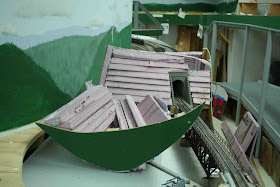As I fill in terrain around my railroad, one scene demanded early attention--Westfir. As seen in previous posts on the bridge at Westfir and Western Lumber, e.g.: https://espeecascades.blogspot.com/2017/10/western-lumber-2.html
This layout corner scene is important to setting the location of my railroad in timber country. Further, the bridge over the North Fork of the Willamette River leads directly into a tunnel through "THE Oak Ridge" into Oakridge. A critical scenic transition is needed here.
Tunnel 22, which pierces the ridge, marks the transition from the Willamette Valley into the Cascades. It also serves as a major visual and operational block at the RR-East end of the Oakridge Yard. The tunnel and bridge challenge my operating crews every bit as much as the prototype geography challenged SP crews. The RR-West face of the tunnel sits almost on top of the RR-East switch at Oakridge. This complicates switching moves at this end of the yard in both model and prototype forms.
During my initial wave of terrain-forming this winter, I built up the contours of the ridge over Tunnel 22. I did not complete the job, as I continued to struggle with the scenic treatment of the river and the log pond for Western Lumber on the Westfir side of the ridge. Along the way, I also found my initial plan for the ridge capped it too high, leading to some too-dramatic cliff faces. I eventually resolved both scenery issues with judicious placement of river dams and a trim to the top of the ridge.
Initial construction of ridge over Tunnel 22. Note the nearly vertical styrafoam panels above the tunnel portal. Also note I have not finalized the terrain reaching down to water level.
RR-West side of the ridge over Tunnel 22--the Oakridge side. Once again, the terrain is too vertical.
The top of the ridge has been cut!
The river and log pond proved more challenging. I needed to convey a sense of place, but my model railroad geography was quite different from the prototype geography. This is where the art of model railroading intervenes. My scene is something of a mirror image of the actual scene, with the railroad curving the opposite direction. I also needed to place Western Lumber between the railroad (outside) and the backdrop (inside). The log pond formed by a dam on the river downstream of the railroad bridge on the prototype needed to be upriver of my modeled bridge. My solution was to build up both the log pond and the river dam upstream of my railroad bridge and then make the best of it with terrain slopes.
Once I fixed the permanent location of the dams and the height of the log pond and adjoining river, the rest of the scene came together. I need to trim a bit of the plywood base seen alongside the backdrop in the photos above. I also needed to trim a bit more of the plywood base around the log chain up from the pond to make that scene come together. I chose to use the previously installed hardboard for the log pond and river at their initial heights, adjusting the dam heights accordingly. This will lead to these surfaces defining their respective water surfaces. The logs in the log pond will need to be trimmed to half logs to represent floating logs on top of what now will be a fairly shallow "water" treatment. That is a small price to pay for resolving this important scene.
Once the fixed elements were in place, I completed the rough terrain form and then applied Sculptamold. After my ridgetop trimming and application of Sculptamold, I found I needed to rebuild a bit of the top of the ridge to provide a smoother contour. This was just fine tuning of the resulting scene. With the deadline of the June 2, layout tour for the NMRA PNR Convention, I worked to flesh out this scene toward a bit more finished appearance. Work remains, but my current sawmill scene matches well to the current level of scenery formation on my railroad.
Revised ridgetop and filled-in rough terrain foam slabs at Westfir. Note the top of the ridge is a bit flat. The ridge was built back up a bit after the first Sculptamold application.
First pass at Sculptmold on the ridge between Westfir and Oakridge. Note the flat spot near the backdrop on the left side of the ridgetop.
Completed Westfir and ridge terrain. The ridgetop is more rounded.
Western Lumber scene at Westfir coming together.
A final note about Tunnel 22. This tunnel was bored during the true E.H. Harriman era as the Southern Pacific built up to and into Oakridge. As such, the tunnel portal and lining conform to the "Harriman Standards" of that period, including the masonry portal and wing walls. I purchased and stockpiled a set of these portals and wing walls years ago when castings for such were commercially available. Little did I know at the time that the pair of portals and walls I acquired would be exactly what I needed for my eventual dream layout. Subsequent construction of the Natron Cutoff (Cascade Line) resumed in 1926 following Mr. Harriman's death, Federal Government legal action, and a 1922 US Supreme Court ruling that cleared the way for line construction. As I noted this past winter as I cast tunnel portals for the rest of my railroad, the rest of my tunnels bear a 1926 construction date and feature a new common design and concrete construction. My Tunnel 22 properly has the masonry portals, contrasting with the rest of the railroad.







Always look forward to the regular updates from your railroad. Love to see "the vision" become reality!
ReplyDeleteBill, you are moving right along.
ReplyDelete